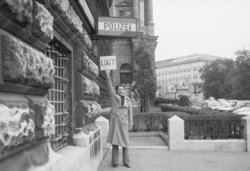Peter Weibel
* 1944 in Odessa, Ukraine.
Artist, curator, art and media theoretician; has studied literature, film, mathematics, medicine, and philosophy in Vienna, Austria and Paris, France.
2009: Awarded the “Friedlieb-Ferdinand-Runge-Prize for Unconventional Art Eduction” by the Foundation Preußische Seehandlung. // Received the “Order of the State of Baden-Würtemberg.” // 2008: Artistic Director of the Sevilla Biennale “BIACS3.” // Received the French Decoration of Honour “Officier l’Ordredes Arts et des Lettres.” // 2007: Awarded the honorary doctorate of the University of Art and Design Helsinki.
Polizei lügt
Taken from the series “Anschläge”, 1972
Die künstlerische Entwicklung des Werkes von Peter Weibel als international anerkannter Medienkünstler und Konzeptkünstler soll von seinen Anfängen bis zur Mitte seines Werkverlaufs nachgezeichnet werden. Er hat als visueller Poet 1964 begonnen und bald die Strukturen der visuellen Kultur von der Seite auf den Bildschirm übertragen und gleichzeitig dabei das Modell der Sprache als Modell der Wahrnehmung im Sinne strukturalistischer und post-strukturalistischer Methoden beibehalten. Durch diese linguistische Fundierung seiner visuellen medialen Arbeiten entwickelte er einen kritischen Impuls, der sich nicht nur gegen die Kunst, sondern auch gegen die Gesellschaft und die Medien selbst wandte. Diese präzise Entwicklung von der Seite über den Bildschirm zum Galerieraum - alles bereits in den 1960er Jahren - hat viele Tendenzen dessen vorweggenommen, was später als Konzeptkunst,
Kontextkunst, institutionelle Kritik, Intervention bezeichnet wurde. Text: Auszug aus dem Text zur Ausstellung “das offne werk 1964-1979”, 2004 in der Neuen Galerie, Landesmuseum Joanneum
The artistic development of Peter Weibel’s oeuvre, which turned him into an internationally acknowledged media and conceptual artist, will be traced from its beginnings to the middle of his creative period. In 1964 he began as a visual poet who quickly transferred the structures of visual arts from the page to the screen while keeping the model of language as the model of perception in the sense of structuralist and post-structuralist methods. With this linguistic
foundation of his visual-medial works, he developed a critical impulse which not only turned against art but also against society and the media. The specific development that made him turn from the page to the screen and then to the gallery space – all already during the 1960s – anticipated many trends that were later called conceptual art, contextual art, institutional critique, and intervention. Text: Excerpt from the text for the exhibition “The Open Work 1964-1979”, in the Neue Galerie Landesmuseum Joanneum, 2004.
Courtesy Galerie Grita Insam Wien


